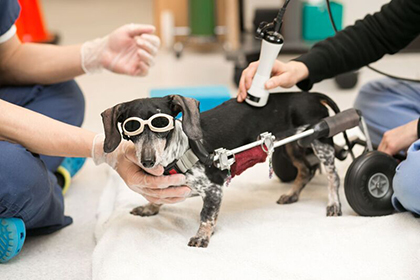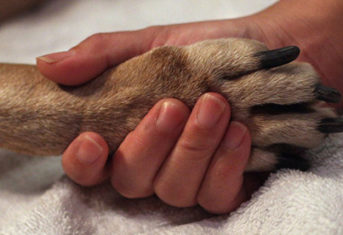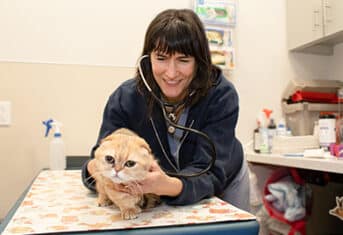Laser Therapy at AMC

Laser Therapy at AMC
A laser is not a thing; it is an acronym which stands for Light Amplification by Stimulated Emission of Radiation. Clearly, laser is simpler. But there is nothing simple about lasers used in medicine. Lasers produce a very narrowly focused beam of light which can be very precisely aimed. Lasers also produce light restricted to a certain wavelength. Restricted wavelengths produce a specific color of light. Lasers can produce visible light or one that cannot be seen by the human eye. Lasers produce beautiful music in our CD players, term papers from our laser printers, and decorate our houses for Christmas. Lasers are important medically and at the Animal Medical Center, we use lasers every day, in many of our 17 key specialties.
Types of Lasers
Lasers convert energy into light. The inside of the laser contains mirrors which bounce the light back and forth, increasing its intensity. The light is also amplified by the medium contained inside the laser. This medium could be a crystal such as the holmium:YAG (yttrium-aluminum-garnet) lasers, a gas, like the carbon dioxide laser, or a semiconductor which is found in a diode laser. The amplified light produced by a laser is both powerful and precise. Each type of laser has different properties and accordingly, different medical uses. The wavelength of the laser light determines how deeply the light penetrates and determines if the laser treats superficially or deeply.
Ophthalmology
Glaucoma is a painful eye condition where excess fluid accumulates in the eye, increasing intraocular pressure. AMC’s ophthalmologist uses a diode laser to ablate the intraocular structure (ciliary body) producing intraocular fluid, helping to control the pain without surgery.
Dentistry and Surgery
These two groups of specialists use the carbon dioxide laser, often for oral surgery. AMC’s veterinary dentists occasionally use the carbon dioxide laser for treatment of oral inflammation that does not respond to other therapies, while the surgeons use it for shortening a long soft palate or removal of oral masses. The laser is favored for these types of procedures because it not only makes a superficial incision and precisely excises tissue, but the CO2 laser also seals blood vessels and nerves, decreasing intraoperative hemorrhage and postoperative pain.
Interventional Radiology/Endoscopy
Using their powerful holmium:YAG laser, the veterinarians on the Intervention Radiology/Endoscopy Service pulverize bladder and kidney stones, allowing the smaller pieces to be passed in the urine and thus be removed out without surgery. Like AMC’s ophthalmologist, the Interventional Service also uses a diode laser to close abnormal ureters or remove bleeding polyps and masses.
Integrative & Rehabilitative Medicine
Multiple different lasers are used as part of rehabilitation therapy for dogs and cats at AMC. Our veterinarians use infrared diode lasers that emit a combination of continuous and pulsed waves to help manage pain associated with osteoarthritis and tendinitis, mange chronic wounds, and even as a feature of therapeutic acupuncture.
Radiation Oncology
Radiation oncologists use lasers every day, and as part of radiation therapy, but not therapeutically. Each patient requires a personalized treatment plan. As part of that plan, the pet’s skin is marked with indelible ink. Laser lights are integral to the radiation machine and are aligned on the skin marks to ensure accurate positioning of the pet for each and every treatment. Accuracy improves cancer control and decreases unwanted effects.
Lasers are high-tech medical devices. Your veterinarian will l help you determine if laser therapy is right for your pet and will choose the appropriate type of laser to meet your pet’s medical needs.































